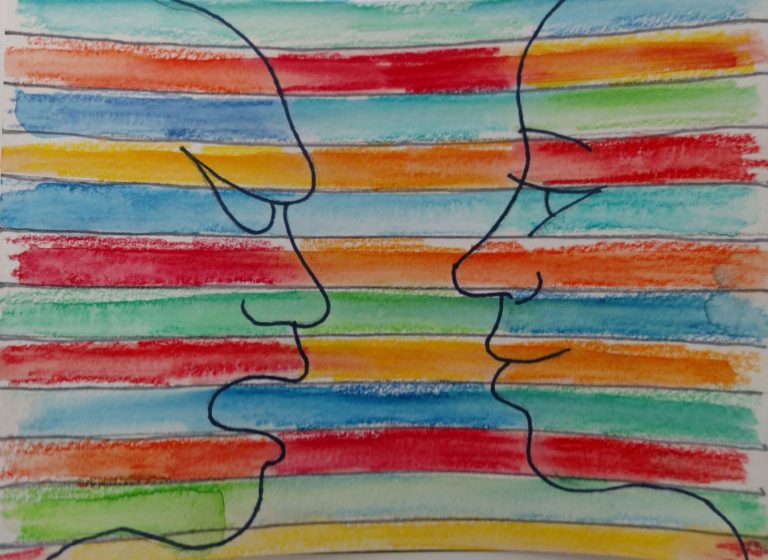Not too long ago I found myself struggling to make a major life decision – whether or not it was time to start my own practice. A part of me knew that the potential benefit for myself and others was great. But another part knew there were great financial and emotional risks involved. Consequently, I sat in this uncomfortable, dissatisfied state of both wanting and not wanting the change for some time. How often do we experience feeling pulled in two directions – a part of us that really wants or feels something and another that wants or feels the exact opposite? Both parts may be equally valid and desirable, or undesirable, and consequently we feel torn – caught between a rock and a hard place.
This completely normal experience of two parts of ourselves operating at cross-purposes is a concept known as polarization. We notice it under obvious circumstances, such as when we desire a change in a job, are trying to convince ourselves to kick a bad habit or leave a toxic relationship. Change is hard because we’re often ambivalent about what change will mean. Desiring seemingly incompatible things at the same time can lead to discomfort, anxiety, and procrastination – often mistaken for resistance or avoidance. We are indecisive and experience mixed feelings. Polarizations are not simply holding two opposite beliefs at the same time, but manifest as internal power struggles, or conflict.
Parts in Polarization
The fact is we as humans are often in conflict with ourselves – internal conflict is a significant aspect of our psyche. For example, we might both desire to express ourselves and be heard yet repress our voices at the same time. Not only do these parts hold opposite positions, they are in conflict with each other. The part that wants to protect ourselves from being judged as foolish or inarticulate actively fights the part that wants to speak up and have our ideas heard. Each is convinced that in order to deal with the other, it must take an extreme stand, resulting in tension and either inaction or rebellion. Which parts of us are typically at odds?
- Managers are pro-active, protective parts of ourselves that work hard by staying alert for danger, controlling situations or relationships, preventing us from being hurt, abandoned, or rejected, and keeping our system functioning through “safe” routine.
- Firefighters are re-active protectors that tend to jump into action especially when an emotionally vulnerable part of us is at risk of being exposed. They “put out the fire” in ways that are commonly considered harmful, but make sense to them, such as eating disorders, risk-taking behaviors, suicidal thoughts, or other self-harming activities.
The behaviors and actions of managers are often socially desirable and supported by our family, colleagues, and society as a whole: “if I work hard to be perfect and please others they will like and accept me”. This contrasts sharply with the typically impulsive, self-destructive and socially undesirable behaviors of firefighters. Internal tension festers as concerned managers attempt to control the actions of the firefighters they judge to be inappropriate or dangerous. An internal power struggle ensues as each part fights to assert which part’s beliefs and actions are in our best interest, resulting in us experiencing high levels of stress, anxiety, and tension.
At its worse, a vicious cycle of harmful firefighter behaviors fuel critical and self-loathing manager responses. As in a tug-of-war, neither is willing to lessen its efforts to pull out of fear that if does, the other will win control and cause us irreparable damage. This tends to be even more extreme and urgent when our parts are attempting to protect us from re-traumatization, becoming harsh, rigid and at times dangerous. All the while, they overlook the fact they are both fiercely battling to protect the same hurt, injured parts of ourselves that fuel their stanch responses.
Giving Voice to Our Polarized Parts
There’s a skit featuring Bob Newhart as a therapist where an individual comes in for help with some fear-based symptoms. Rather than exploring the underlying cause and offering compassion toward this person’s suffering, he simply instructs “Stop it!”. While in jest, there’s an appeal to the simplicity of this solution; wouldn’t it be amazing if our parts could just stop the battle on command? We know full well that telling our polarized parts to “stop” or trying to silence or ignore them is unlikely to have long term impact – more often they become louder and more persistent. Like a child incessantly tugging on a parent’s shirt, begging for attention, they are unlikely to release their grip and relent when told to go away or let go (“stop it”), whining louder and more intently until they feel attended to.
The Internal Family Systems (IFS) approach works with polarized parts by helping us find the parts (how we experience them, often physically), focus on them individually so they are heard, reassure them we won’t side with one part over the other, explore their concerns, and help the parts communicate their perspective with each other all with the presence of Self energy, such as curiosity, compassion, and courage.
Creativity and Bilateral Art
As an art therapist, I find another quality of Self, creativity, can be instrumental in addressing polarities. The creative process allows us to explore and give voice to our parts in novel ways. One exercise I often use in sessions to help with polarizations is bilateral art making. This art therapy technique utilizes both hands in the process of visually depicting the polarized positions of the battling parts.
Using a sheet of paper divided down the middle by a clear line, I invite the individual to decide which hand is most connected with, or would like to communicate for, which of the two conflicted parts and then checking to see which part wants to express their position first. The individual then focuses on this part, using the IFS approach of finding and focusing on it, and then depicts on the side of the paper corresponding with the hand drawing (left or right) whatever comes to mind. This process is repeated for the second part with the hand visually communicating for it. After both parts have expressed themselves, the individual then choses a side to explore or trace using the hand that did not create the image, and then repeats this with the opposite side and hand. After both sides of the art have been explored by the opposite hands, both hands are invited to explore both drawings in whatever way they feel helpful. We then process this further, including what the individual has learned or discovered.
This bilateral art intervention assists with facilitating communication and understanding of the positions of the internal parts at odds, allowing them to be heard and attended to by each other and with the presence of Self. Rather than simply being cognitively aware that there is a conflict, it creates an emotional awareness on a deeper, more connected level. The parts can slowly and mutually lessen their pull once they feel heard and understood, trusting that with Self in charge, one will not overtake the other and cause further pain and suffering. This often results in reduced tension, increased comfort in making a decision or taking action, and can set the stage for transformative healing.


